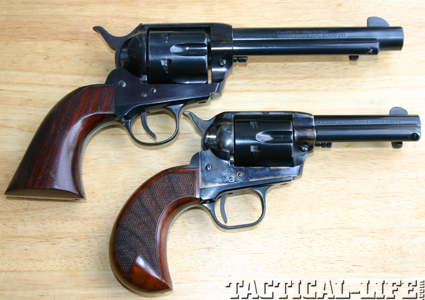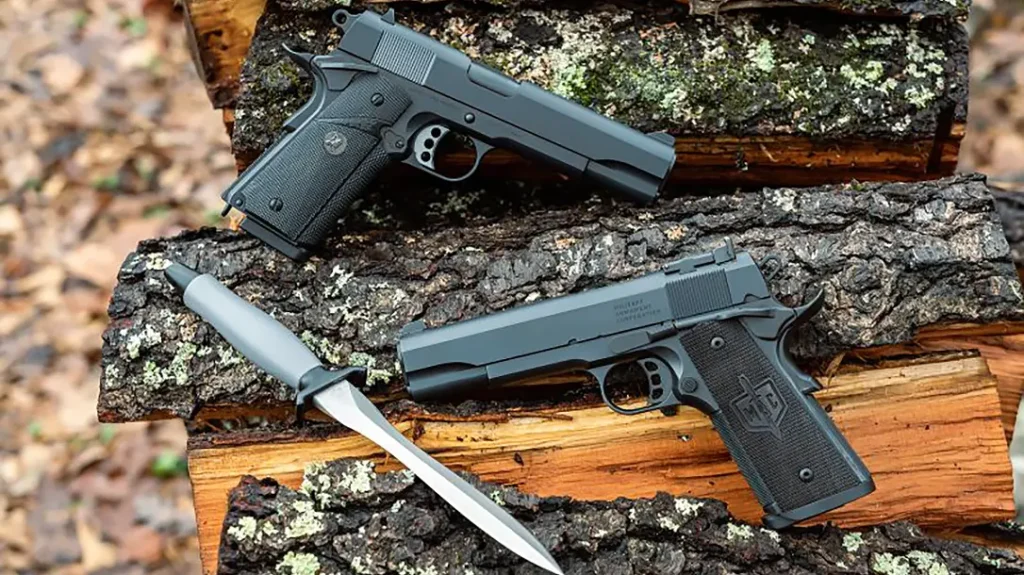Here you can compare the Uberti OWD with a replica of a full-size Colt Model P (SAA) with a 5.5” barrel (top). In the late 19th century the OWD would have been considered a “pocket pistol.”
Size matters. Unlike what you see in Western movies or on television, not everyone in the Old West era who packed a gun went around with a big “hog-leg” in a low-slung holster that was dangling from a wide cartridge belt strapped low on the waist. Many folks from all walks of life—shopkeepers, bankers, and bartenders—liked to keep a handgun discretely concealed on their person. The same went for sheriffs, marshals, policemen, and detectives; then of course you have to add gamblers, outlaws, and even “soiled doves.” For that reason, all of your handgun manufacturers not only had big “horse pistols” in their line but also included a selection of smaller “hide-out guns,” usually ranging in bore size from .22 to .41 in rimfire (RF) and centerfire (CF) models.
Lightning & Thunderer
One of those manufacturers was Colt’s Patent Firearms of Hartford, Connecticut. Early on Samuel Colt designed small percussion Patterson Model revolvers and later on his cap ‘n ball 1849 Pocket Model in .31 caliber turned out to be his top-seller. When the Civil War ended and the move to fixed metallic cartridge firearms was underway Colt first concentrated on a big single-action revolver for the military, but as soon as they won a government contract for the 1873 SAA, they turned their attention to the civilian market.
Advertisement — Continue Reading Below
One early cartridge-firing cowboy revolver was the Colts House Pistol also known as the “Cloverleaf” due to the shape of its 4-shot cylinder. This was a .41 RF SA revolver with a spur trigger and a 1.5- to 3-inch barrel. Colt also made single-shot derringers in .22 and .41 RF often referred to as “Muff Pistols” as they were often carried on cool nights by ladies with their hands inside fur muffs. In 1877 Colt came out with some more serious handguns for defensive use. They looked a lot like the SAA only they were scaled down a bit and chambered for the .38 Long Colt and .41 Colt, plus they had double-action (DA) firing mechanisms. Both held six cartridges and were known as the Lightning (.38 CF) and the Thunderer (.41 CF). Some 167,000 or so were manufactured up until 1909 when production ceased.
The Lightning was the smallest of the pair, although for a short period in 1877, Colt made a version in .32 Colt called the Rainmaker that today is extremely rare. Anyway, the 1877 Model was Colt’s first attempt at a DA revolver. Unfortunately, the action of the two six-guns was overcomplicated and fragile, so most ended up on the benches of gunsmiths who quickly came to dislike their intricate design.
The Lightning was an ideal hideout gun and offered a good compromise between size and firepower. Barrel lengths ran from short 1.5-inch tubes to long 10-inch models that were more appropriate for belt carry. Of course, back in the day, Colt was more than willing to cut the barrel to whatever length you wanted. The barrels were marked on the left side COLT D.A. 38 and the 1.5- to 6-inch guns could be had with no ejector rod, while the 4.5- to 10-inch models did.
Advertisement — Continue Reading Below
Texas bad-man John Wesley Hardin was reputed to pack a Lightning—as did a well-known British Detective of the Victorian period named Jerome Caminada, who became the superintendent of the Manchester Criminal Investigations Division (CID) and was nicknamed the “Sherlock Holmes” of Manchester. Lightnings were also used by American Express guards and agents, while examples have been found marked Policia Del Distrito Federal (Mexico City Police).
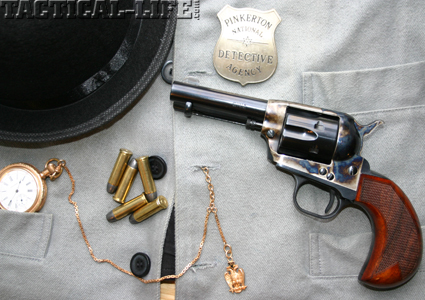
Produced by Uberti on the .22 Stallion frame, the OWD (Old West Defense) is a compact six-gun in .38 Long Colt/.38 Special and would have been the perfect hideout gun for a Pinkerton man or Wells Fargo operative.
Gun Details
The Colt Lightning is long gone, however, over the years there have been a number of SA six-shooters that have the look if not the action of the Lightning. This leads us to a handgun introduced by Uberti—the Bird’s Head Stallion Old West Defense (OWD). This gun is a version of the Stallion series of small-scale SA revolvers. It very much resembles the 1873 SAA, but the original Stallions were chambered in .22 LR and .22 WMR only. This version says on the left side of the barrel that it will take .38 Colt & S&W Spec. It has a 3.5-inch barrel that is equipped with an ejector rod/housing and the “plow handle” grip frame ends at the butt in what has become known as the “birdshead” alluding to its shape.
Advertisement — Continue Reading Below
In my estimation, the OWD moniker fits this gun very well owing to its amalgamation of compact size, lethality, and concealability. Were I a Pinkerton man or Wells Fargo operative, it would certainly rate high on my list as a carry gun for locales where I’d want to be discretely armed. Of course in reality it’s a fantasy gun, as nothing like this that I’m aware of ever came off a 19th-century production line, but at the same time, its late 1800s roots are more than evident. It has the classic “four click action” as you thumb the hammer back to full-cock, but then you will note that the firing pin is obviously not riveted to the hammer nose, but mounted inside the frame.
Beware; this is not a spring-loaded, inertia-type firing pin, so when the hammer is at rest the firing pin protrudes through the breech face. It will lie against a primer if the chamber under the hammer is loaded and a blow to said hammer could have dire consequences. This means that your six-shooter is best carried as a five-shooter—then again any dyed-in-the-wool Cowboy Action Shooter will do that anyway.
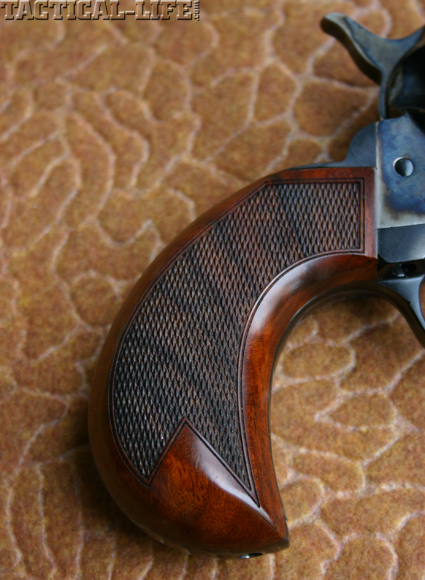
Like the Colt Lightning, the Uberti OWD has a “birdshead” grip, so-named because of its looks. The grips are one-piece walnut with nice hand checkering.
Advertisement — Continue Reading Below
Another noteworthy feature is the rebated cylinder chambers. While this might have been a good idea in the days of “balloon-head” cartridge cases, I don’t really see the “why and wherefore” today. To me, on a “cowboy” revolver it just makes things a little more difficult at the loading table of a CAS match. The cowpoke manning the table has to be extra careful because he can’t see the breech-end of the cylinder to verify that the chamber under the hammer is empty. Aside from that, I really don’t have any other adverse comments to make about the OWD.
An external examination demonstrated a superb level of quality and workmanship. The barrel, cylinder and grip frame/trigger guard are expertly polished and deeply blued. This blends in well with the blues and grays of the color casehardened frame and hammer. Wood-to-metal and metal-to-metal fit is top shelf. One-piece walnut grips adorn the OWD and they are skillfully checkered adding to their looks and utility.
I noted that the OWD has a healthy hammer spring, but the trigger pull has the bare minimum of creep and breaks at about 4 pounds. The front sight is a fairly low blade that is 0.125 inches wide, making it easier to see and quicker to get on target. The fixed rear sight notch is corresponding in width and I found later on that the sights were rather well regulated. Like other short-barrel SA revolvers that I’ve handled lately, removal of the OWD cylinder can be challenging. In order to pull out the base pin, you have to get by the ejector rod head and the only way you can do that is to push it all the way back as far as it will go. The challenge is holding it back under spring tension while you press in on the base pin release and simultaneously withdraw the pin. I did it; so can you.
Advertisement — Continue Reading Below
Shooting Impressions
As with all the CAS-related guns I receive to test, I wanted to shoot the Uberti OWD in a SASS-approved CAS match, but first I had to know where the sights were on this diminutive centerfire six-gun. I headed down to the ammunition locker and since the barrel is stamped .38 Colt, I grabbed a box of Black Hills cowboy loads in .38 Long Colt, which carries a 158-grain round-nose, flat-pointed bullet. I also included .38 Special cowboy loads from Hornady, which had a 140-grain bullet; Ten-X with a 130-grain bullet and Winchester with a 158-grain bullet — all are lead with flat points. I put up a round, medium-sized 8-inch target to get an idea on the sights and then proceeded to shoot a few rounds with each load with the target at the 7-yard line. Using a two-handed hold, I put 15 rounds into the center of the target, most in the red X-ring, with no hits outside the 10-ring.
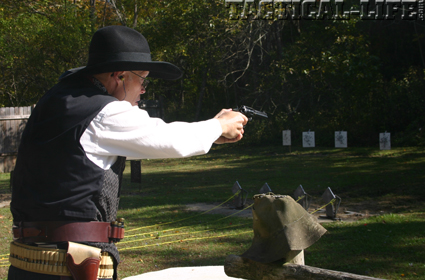
Author put the OWD through its paces at a two day, 10 stage CAS match and found the little sixgun to be fast-handling, reliable and the grips fit his hand to a ‘T.’
To check the accuracy potential of the OWD, I moved the target stand out to 10 yards and from the bench shot four 5-shot groups with each of the test cartridges using oval-shaped targets. Results were somewhat mixed, and nearly all of the less-than-the-best groups were my fault. I had a little trouble seeing the rounded front sight and the 4+1 Syndrome was alive and well, spoiling a number of nice tight groups. Still, all in all my best group measured a scant 0.65 inches and was just one enlarged hole using the Ten-X .38 Special cartridges. Second place went to the Hornady cowboy loads with a 1.61-inch cluster and it seemed that both the shooter and the gun preferred the ammunition with the lighter weight bullets. My point of aim was pretty much 6 o’clock of dead center and as I mentioned earlier, the fixed sights were very well regulated.
Advertisement — Continue Reading Below
Competition Time
As a primer for the upcoming CAS competition, I loaded up the Uberti Old West Defense .38 Special revolver with various mixtures of test ammunition and did some rapid-fire shooting at a full-size silhouette target from about 5 yards. The target was light blue in color, which, along with the wide front sight and generous rear sight notch, really helped me in the acquisition of a quick sight picture. The gun seemed to fit well in my medium-sized hand and using a two-handed hold I found it very easy to rapidly manipulate the hammer. The birdshead grip felt natural in my hand and the finely checkered panels on the side of the grips greatly assisted in shot-to-shot recovery. All that was left to do now was to hunt through my cowboy leather gear collection and come up with a holster and belt that would work well with the reduced-size frame and short barrel.
For the upcoming CAS match I selected a holster from El Paso Saddlery that normally carries a .22 RF SA revolver. It is called the 1890 “Original” and has a single loop that is riveted to a wide skirt so you can easily thread it onto a full-size cartridge belt. Mine is finished in a russet brown with a border stamping and is lined; a hammer thong is standard equipment. This holster was reputed to have been carried by both Texas Ranger Captain John Hughes and the killer of John Wesley Hardin, El Paso Constable John Selman. It was mated with a canvas and leather cartridge belt of unknown make that I’ve had in my leather collection for many years.
The CAS match to which I took the Stoeger OWD revolver was a two-day, 10-stage event hosted by the Pleasant Valley Renegades SASS Club. The first six main match stages were shot and Saturday with the final four stages and awards coming on Sunday. I paired my OWD with a Ruger New Vaquero in .38/.357 and my long guns included a Stoeger 12 Gauge Coach Gun and an 1873 Winchester carbine also in .38/.357 caliber. As I often do, I shot in the 49’er classification. The OWD performed admirably and I found it was quick to get on target and easy to control in rapid fire. The checkered birdshead grip and my hand were a perfect combination. I walked away on Saturday with maybe not the best of recorded times, but no procedurals or misses.
Advertisement — Continue Reading Below
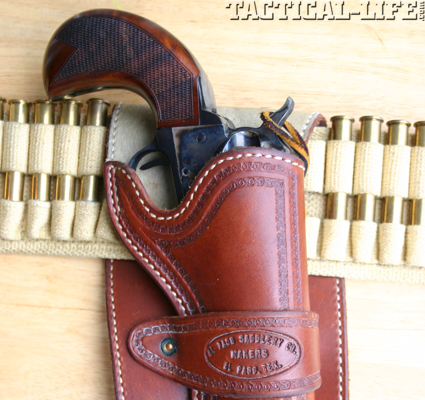
For belt carry the Stoeger OWD fits just fine in holsters made for .22 SA revolvers. This El Paso Saddlery 1890 “Original” holster fir the OWD perfectly.
On Day Two I really thought I had the potential to shoot a clean match, but the last round, on the last target, with my lever gun, I let one go too early and hit the grass about 6 inches to the left of the target. So much for a clean match — so I then decided to concentrate on speed. I ramped things up a bit and thought I had improved my times somewhat. It irked me just a tad that I did not have another miss the rest of the day and would have had a clean shoot except for that one lousy shot. Cowboy-up Bill! I ended up with a green 4th Place ribbon in 49’er, the first one I have ever received.
Final Notes
Advertisement — Continue Reading Below
I really enjoyed shooting the Stoeger Old West Defense six-shooter and despite its small size I think it works great for SASS competition. I still don’t like the rebated cylinder chambers, but I think its good points far outweigh the bad and would seriously consider it for my battery and for a new shooter, buckaroo or cowgirl, it might be ideal.
